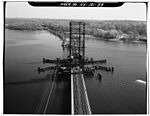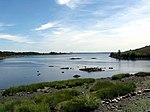Pelham Bridge

The Pelham Bridge is a bascule bridge located in the New York City borough of the Bronx, just downstream of the railroad Pelham Bay Bridge. It carries Shore Road and a walkway along the downstream side, over the Hutchinson River. The bridge is operated and maintained by the New York City Department of Transportation. Crossing the mouth of the river, it is variously called Pelham Bay Bridge and Pelham Bridge. The BL45 to/from Eastchester in Westchester County as well as the Bx29, which operates between City Island and Co-op City, operates over this bridge. The Pelham Bridge opens for maritime traffic frequently; in 2014, it opened 724 times. The watercraft traffic under that bridge is greater than for any other drawbridge in the city.
Excerpt from the Wikipedia article Pelham Bridge (License: CC BY-SA 3.0, Authors, Images).Pelham Bridge
Mosholu-Pelham Greenway, New York The Bronx
Geographical coordinates (GPS) Address External links Nearby Places Show on map
Geographical coordinates (GPS)
| Latitude | Longitude |
|---|---|
| N 40.86204 ° | E -73.81582 ° |
Address
Pelham Bridge
Mosholu-Pelham Greenway
10475 New York, The Bronx
New York, United States
Open on Google Maps







